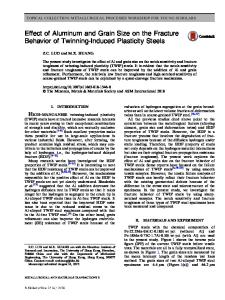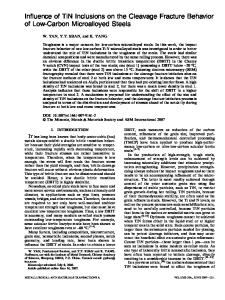The Role of Plastic Strain on the Delayed Fracture Behavior of Twinning-Induced Plasticity Steels
- PDF / 3,526,459 Bytes
- 11 Pages / 593.972 x 792 pts Page_size
- 59 Downloads / 331 Views
.
INTRODUCTION
DELAYED fracture (DF) can be defined as the fracture of materials under static loading, which is associated with the attack from the surrounding environment, such as hydrogen and chloride.[1–3] During the past decades, the DF of advanced high-strength steels (AHSS), in particular twinning-induced plasticity (TWIP) steels,[4–7] quenching and partitioning (Q&P) steels,[8–10] and medium manganese transformation-induced plasticity (TRIP) steels,[11,12] has received intensive research interests. Furthermore, due to the TWIP or TRIP effects, the deformed microstructures of TWIP and TRIP steels contain deformation twins or strain-induced martensite, which are vulnerable to the attack from the corrosive environment.[13,14] Therefore, the assessment of the DF phenomenon and understanding its interaction with the microstructure becomes vital for engineering applications of these AHSS. Many methods have been developed for evaluating the DF of AHSS. For instance, the slow strain rate test (SSRT) on the in-situ hydrogen-charging (or precharged) specimens, combined with the hydrogen thermal desorption spectrometry (TDS) analysis, have been used to investigate the correlations between diffusible hydrogen content and the loss of ductility (or strength) of AHSS.[4,5,15,16] It has been widely reported that TWIP Z.C. LUO and M.X. HUANG are with the Department of Mechanical Engineering, The University of Hong Kong, Pokfulam Road, Hong Kong, China and also with the Shenzhen Institute of Research and Innovation, The University of Hong Kong, Shenzhen 518000, China. Contact e-mail: [email protected] R.D. LIU and X. WANG are with the Iron and Steel Research Institute, Ansteel Group, Anshan 112004, China. H.W. YEN is with the Department of Materials Science and Engineering, National Taiwan University, Taipei 10617, Taiwan. Manuscript submitted May 14, 2018.
METALLURGICAL AND MATERIALS TRANSACTIONS A
steels possess significant hydrogen embrittlement (HE) susceptibility.[4,5,14,17–20] However, the investigation on the HE susceptibility of TWIP steels cannot be applied directly to interpret their DF behaviors in a corrosive environment because of the differences in the stress state and environmental condition. Cup drawing is another method used for evaluating the DF susceptibility of AHSS.[19,21–24] Previous studies using deep-drawn cup specimens have shown that the TWIP steels possess high DF susceptibility in various environments.[22,25] Furthermore, the DF susceptibility of TWIP steels can be reduced effectively by the addition of Al.[21,22] Compared to the SSRT, the cup drawing experiment combined with subsequent dipping tests are close to the real forming and service condition.[22] However, the mechanisms responsible for the DF of these deep-drawn cup specimens have received less attention in the previous studies. For the deep-drawn cup specimens, residual stress is a crucial factor for the occurrence of DF. It has been reported that the DF of TWIP steels cup specimens can be removed after the residual stress being released by tem
Data Loading...











